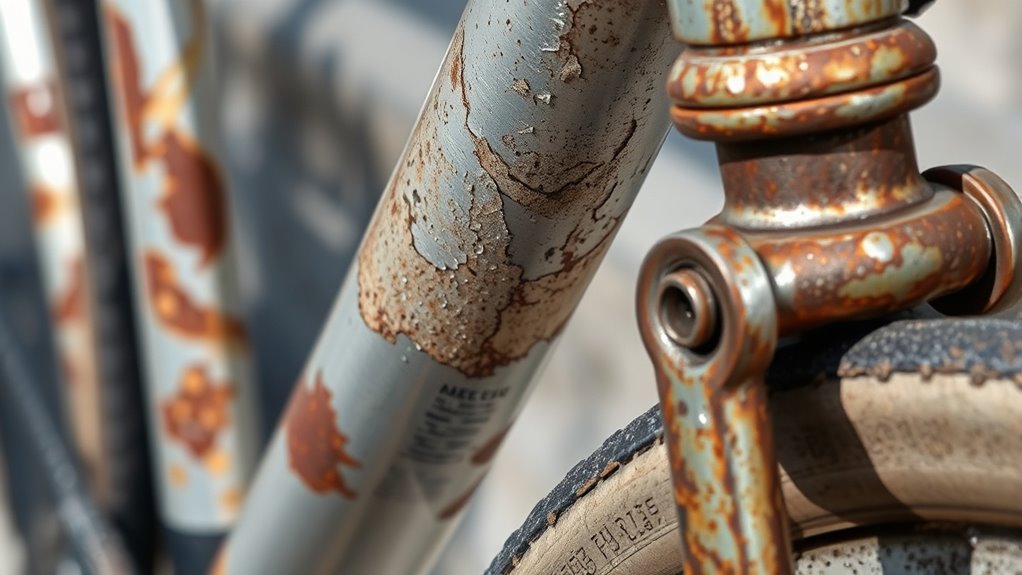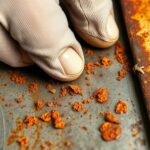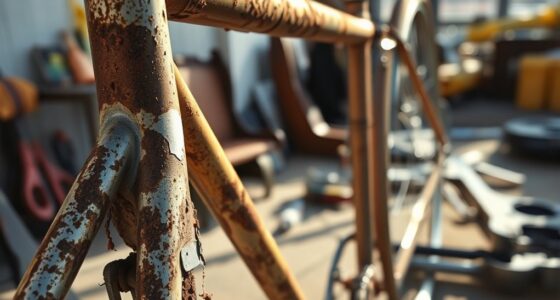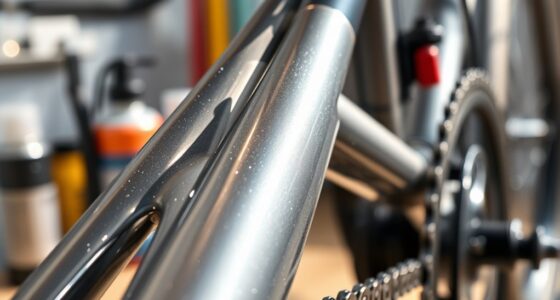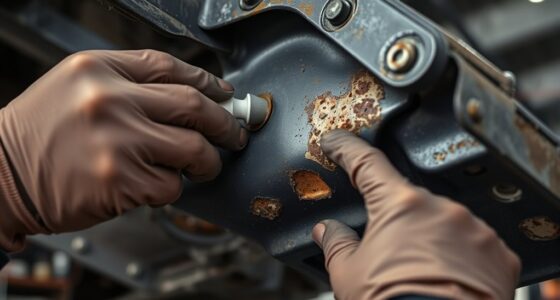Galvanic corrosion on bikes happens when different metals touch in moist conditions, creating an electrical current that speeds up rust and deterioration. This often occurs at joints, fasteners, or areas with exposed metal. To prevent it, avoid mixing metals like aluminum and steel, and protect vulnerable spots with coatings or corrosion-resistant parts. Staying vigilant about signs of corrosion can save your bike. Keep exploring to discover more ways to shield your bike from damage.
Key Takeaways
- Galvanic corrosion occurs when dissimilar metals on a bike contact in the presence of moisture or water.
- Visible signs include rust, pitting, and deterioration at metal contact points.
- Using protective coatings and corrosion-resistant materials helps prevent galvanic corrosion.
- Ensuring proper assembly and avoiding direct metal-to-metal contact reduces corrosion risk.
- Regular maintenance and inspection can identify early corrosion signs and mitigate damage.
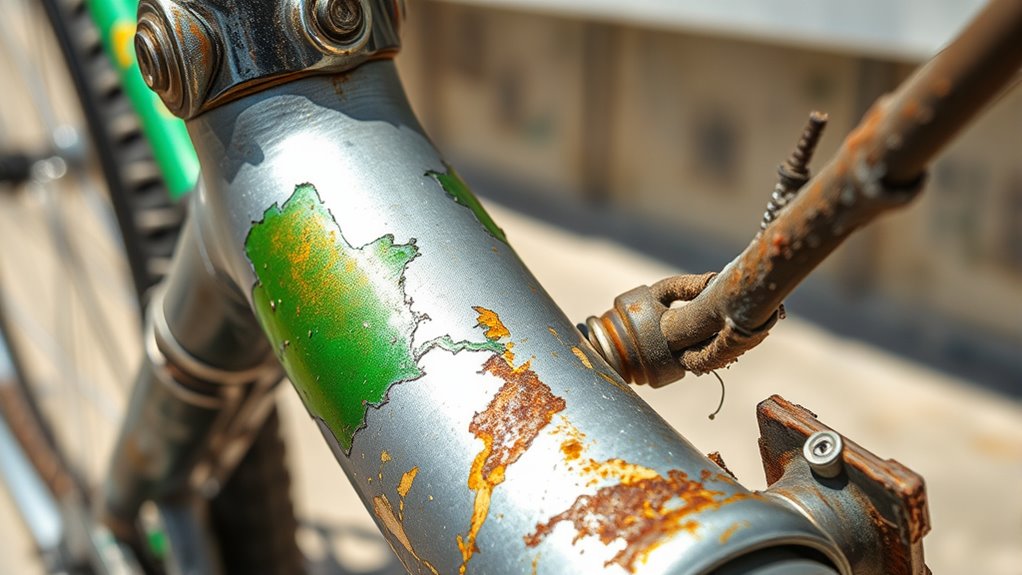
Galvanic corrosion occurs when different metals in your bike come into contact with each other and an electrolyte, like water or moisture, facilitating a chemical reaction that causes deterioration. This process happens because each metal has a different electrical potential, and when they touch with a conductive electrolyte present, an electrical current flows between them. Over time, this current leads to corrosion on one of the metals, often the one more prone to oxidation. You might notice rust or pitting forming on certain parts of your bike if this corrosion isn’t addressed. To prevent this, understanding metal pairing is essential. Not all metals are compatible; some, like aluminum and steel, create a galvanic cell that accelerates corrosion. When assembling or repairing your bike, choosing metals wisely can make a big difference in its longevity.
One effective way to minimize galvanic corrosion is by applying protective coatings. These coatings act as barriers, preventing moisture and electrolytes from reaching the metal surfaces. For example, using paint, powder coating, or specialized corrosion-resistant sprays on vulnerable parts can greatly reduce the risk. When you apply protective coatings, make sure they are even and cover all exposed areas, especially where different metals meet. This step is especially important around joints, fasteners, and areas prone to water accumulation. Protecting these spots helps break the electrical circuit needed for galvanic corrosion to occur. Additionally, selecting corrosion-resistant materials when possible can also help reduce the risk of galvanic reactions happening over time.
Frequently Asked Questions
How Can I Prevent Galvanic Corrosion on My Bike?
To prevent galvanic corrosion on your bike, start by choosing compatible materials and avoid mixing metals like aluminum and steel. Apply protective coatings such as paint or sealants to vulnerable areas, and regularly clean your bike to remove dirt and moisture. Additionally, consider using insulating barriers like rubber washers between different metals. These steps help reduce metal contact and moisture, effectively preventing galvanic corrosion and prolonging your bike’s lifespan.
What Are the Signs of Galvanic Corrosion on Bike Parts?
Think of galvanic corrosion as a silent illness slipping into your bike’s veins. You’ll notice discoloration, often a dull or greenish hue, on metal parts, or pitting that looks like tiny craters. These signs come from electrochemical reactions caused by material incompatibility, where dissimilar metals react. If you see these symptoms, it’s a clear signal that material incompatibility is at work, slowly weakening your bike’s integrity. Stay vigilant and keep your parts in harmony.
Does Galvanic Corrosion Only Occur in Freshwater or Also Saltwater?
Galvanic corrosion can happen in both freshwater and saltwater environments. When metal pairing occurs, especially if they’re dissimilar metals, and there’s a lack of proper electrical grounding, corrosion is more likely. Saltwater accelerates this process because it conducts electricity better, increasing the chances of galvanic corrosion. To prevent this, guarantee proper electrical grounding and avoid pairing incompatible metals on your bike, especially in salty conditions.
Are Certain Bike Materials More Prone to Galvanic Corrosion?
Your bike’s materials aren’t all equally brave against galvanic corrosion; some are more prone than others. Metals like aluminum and certain alloys, especially when paired with incompatible materials, can corrode faster than you’d believe. To prevent this, prioritize material compatibility and choose components with high corrosion resistance. Using proper coatings and isolators can save your bike from the destructive power of galvanic reactions, keeping it strong for miles to come.
How Often Should I Inspect My Bike for Galvanic Corrosion?
You should perform a galvanic corrosion inspection at regular intervals, ideally every 3 to 6 months, depending on riding conditions. During your frequency check, look for discoloration, oxidation, or unusual wear on metal parts, especially where different metals meet. Regular inspection intervals help catch early signs of corrosion, allowing you to take preventive measures and extend your bike’s lifespan. Don’t skip these checks, especially if you ride in wet or salty environments.
Conclusion
Understanding galvanic corrosion helps you protect your bike’s integrity, but ignoring it can lead to costly repairs. While your shiny frame and metal components seem harmless together, they might secretly be working against each other beneath the surface. By taking simple precautions, you keep your bike’s strength intact. Remember, what looks like a minor nuisance today could become a major problem tomorrow—so stay vigilant, and let your bike’s durability outshine any hidden corrosion.
